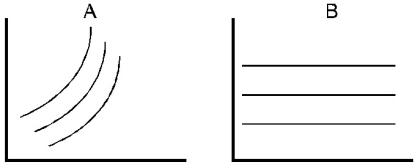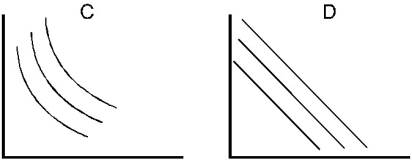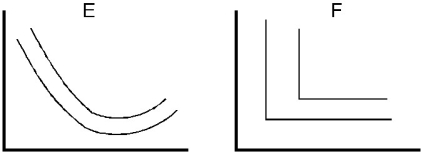Match the following descriptions of preferences to the indifference curve diagrams that follow.
________ Ann does not care whether she has more diet soft drinks or fewer
diet soft drinks.
________ Peter is very picky about his buttered popcorn. He tops every quart
of popped corn with exactly one quarter cup of melted butter.
________ Amy likes M&M's, plain and peanut. For Amy, the marginal rate of
substitution between plain and peanut M&M's does not vary with the
quantities of plain and peanut M&M's she consumes.
________ George dislikes broccoli and would be willing to pay something to not
have to eat it.
________ Natalya likes rap and rock music. Natalya's preferences exhibit a
diminishing marginal rate of substitution between the two types of music.
________ Matthew knows his limit. He likes beer up to a point, but if he drinks
too much he gets sick. 


Definitions:
Fixed Overhead Budget Variance
The difference between the actual fixed overhead costs incurred and the fixed overhead costs that were budgeted.
Standard Machine-Hours
The estimated hours a machine is expected to operate under normal conditions.
Variable Overhead Efficiency Variance
The difference between the standard cost of variable overhead allocated for the actual output and the actual variable overhead incurred, reflecting efficiency in using resources.
Standard Machine-Hours
A predetermined measure of how many hours of machine time should be used for a given level of production output.
Q9: Sally consumes two goods, X and Y.
Q14: Ford Motor Company was one of the
Q39: See Scenario 4.1. What is Daniel's income-consumption
Q50: Tad's Baitshop currently uses no computers in
Q57: Hulk goes to the gym 20 times
Q59: Which of the following events will help
Q92: The aggregate demand for good X is
Q117: The situation pictured in Figure 6.3<br>A) is
Q130: Refer to Figure 2.1. At point C,
Q143: Envision a graph with meat on the